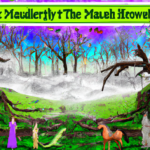
Introduction
Fantasy has been a beloved genre for centuries, capturing imaginations and transporting readers to other worlds filled with magic and wonder. Within the realm of fantasy, there exists a sub-genre known as high fantasy, characterized by its intricate world-building, magical elements, and epic storytelling. High fantasy works have provided inspiration for countless other stories across a multitude of media, from books to film to video games. In this article, we will be revisiting some of the most iconic and classic high fantasy works of all time, exploring what makes them so majestic, and how they continue to influence the genre to this day.
What is High Fantasy?
High fantasy is a sub-genre of fantasy literature that is characterized by various elements such as magical worlds, mythical creatures, epic heroes, and intricate plots. The term “high” in high fantasy refers to the grandiose and serious themes, as well as the complex world-building and intricate character development that are typical of these works. High fantasy is often set in fictional worlds, featuring an array of supernatural beings, from dragons and elves to wizards and goblins. It’s a genre that often explores themes such as good versus evil, the nature of power, and the human condition. While it can be challenging to define high fantasy, it ultimately provides readers with an opportunity to immerse themselves in a fully-realized world where anything is possible.
The Popularity of High Fantasy Works
The popularity of high fantasy works has grown immensely over the last few decades. With increased accessibility to books, movies, and television shows, high fantasy has become a mainstream genre that appeals to a wide audience. One of the reasons for its popularity is that it offers a form of escapism from the real world. Readers are transported to magical realms, where they can journey alongside epic heroes, experience thrilling adventures, and encounter mythical creatures. Another reason for the genre’s popularity is that it offers a sense of wonder and excitement. High fantasy stories are often characterized by vivid and imaginative descriptions, creating a sense of awe and wonder that captivates readers. In addition, high fantasy provides a limitless potential for creativity and new storylines. As readers become engrossed in these fictional worlds, they become attached to the characters and the settings and eagerly anticipate sequels and further installments. Overall, the popularity of high fantasy works can be attributed to its ability to offer readers a sense of adventure, escapism, and limitless creativity.
Classic High Fantasy Novels and Series
The world of high fantasy is filled with many classic novels and series that have defined the genre. J.R.R. Tolkien’s The Lord of the Rings trilogy is one such example. It is one of the most famous works of high fantasy, containing all of the characteristics that define the genre. His world-building, attention to detail, and depth of characters have made the novels a staple in the genre. Another classic is C.S. Lewis’s The Chronicles of Narnia series, which is especially popular among children. It is a series that combines elements of high fantasy, as well as British folklore and mythology, to create a unique, magical world. Ursula K. Le Guin’s Earthsea series is another classic work of high fantasy that has become a staple of the genre. The novels explore themes of power, identity, and the nature of magic, all while taking readers on an exciting journey through the world of Earthsea. Other notable high fantasy works include The Wheel of Time series by Robert Jordan, The Kingkiller Chronicle by Patrick Rothfuss, and A Song of Ice and Fire by George R.R. Martin. These classic high fantasy works have cemented their place in literary history and continue to inspire a new generation of authors and readers.
Elements of High Fantasy that Make them Majestic
High fantasy literature has several elements that make it majestic and awe-inspiring. One of the key elements is world-building, where the authors create vast and intricate fictional universes with their own sets of rules, cultures, and complex political systems. Another element is the use of magic, which is often a central theme and integral to the plot. Magic in these works can take many forms, from simple spells to entire worlds created by spells or sorcery. High fantasy works also typically feature epic heroes embarking on quests or adventures, sometimes with a team of companions, all striving to overcome great odds and conquer seemingly impossible challenges. Along the way, these heroes face many obstacles, including terrifying monsters, ancient curses, and dark villains whose powers threaten to destroy everything the heroes hold dear. High fantasy works also frequently incorporate themes of good vs. evil, with the heroes fighting against dark forces that threaten to destroy their world. Finally, the use of mythical creatures, such as dragons, elves, and dwarves, is another element that makes high fantasy majestic. These creatures are often central to the story, adding to the wonder and mystique of the world the author has created. All of these elements work together to create a sense of wonder and awe in the reader, making high fantasy literature a truly majestic genre.
How High Fantasy has Influenced Pop Culture
High fantasy has had a significant impact on pop culture, inspiring countless books, movies, television shows, and other forms of entertainment. One of the most obvious examples of its influence is J.R.R. Tolkien’s The Lord Of The Rings trilogy, which has been translated into over 40 languages and adapted into a highly successful movie franchise. The intricate world-building, engaging character development, and epic storylines of high fantasy have also inspired video games like Skyrim and World of Warcraft, which have become some of the most popular games of our time. Additionally, the concepts of magic, mythical creatures, and epic quests have infiltrated the world of comics, influencing the creation of characters like Thor, Loki, and Doctor Strange. Even modern-day music has drawn inspiration from the genre. Many popular symphonic and cinematic metal bands, such as Nightwish, Blind Guardian, and Epica, draw inspiration from high fantasy works, weaving their storytelling into their music. It is safe to say that the influence of high fantasy on pop culture is profound and enduring. It remains an essential genre that continues to inspire, entertain, and broaden the imaginations of people around the world.
Conclusion
In conclusion, high fantasy is a genre that has captured imaginations and transported readers to other worlds filled with magic, wonder, and awe. The genre has become an important part of literary history, with classic works like The Lord of the Rings and The Chronicles of Narnia leaving an indelible mark on the genre. Through intricate world-building, the use of magic, epic heroes, mythical creatures, and themes of good vs. evil, high fantasy works have established a sense of wonder and escapism that readers have come to love. The influence of high fantasy on pop culture is also evident, as it has inspired movies, video games, comics, and music, cementing its place in modern-day culture. High fantasy continues to be an ever-evolving genre with each new author bringing their own spin and creativity. It remains an essential genre that offers readers the opportunity to explore new worlds and unleash their imaginations.







